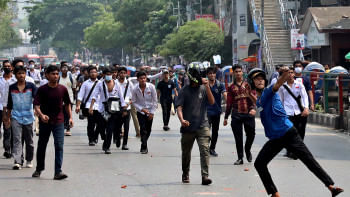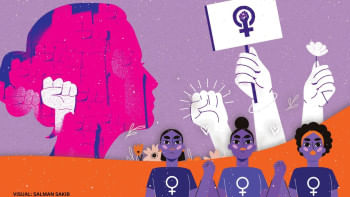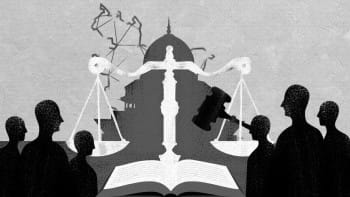Domestic violence in Bangladesh: When numbers speak of the silence

Numbers always have an effect. The larger the number, the greater the impact on the human psyche. So when we are informed that 133 women have been killed by their husbands in the first seven months of 2025, it is no longer just a number—it's a punch in the stomach that leaves us sickened and reeling. Because these women were murdered in what should have been their safest place, their homes, by the very person they were told they could trust the most, their life partner.
But why do these numbers still shock us? Is it because we didn't realise the extent of this horrific crime? Or is it because deep down we have accepted a lie, that violence within marriage is a "private affair" and to an extent not that big of a deal? So deep is this normalisation that when women cry out for help, they are often told to "bear with it," for the sake of their children, for their families' "honour," for financial survival. Ultimately, that phrase—to "just bear with it"—becomes a death sentence.
On August 13 this year, 26-year-old Syeda Fahmida Keya was allegedly killed by her husband Sifat Ali. According to Keya's family, the eldest of their four children, who is 11 years old, told them how it happened. That night, Fahmida was preparing dinner when Sifat returned home. An argument began and Sifat began to hit her, apparently a usual occurrence in that household. Sifat forced her into a room and locked the door. At around 2am, Sifat called Keya's family and asked them to come home quickly, saying she was "seriously ill." He directed them first to the Dhaka Medical College Hospital and then to a private hospital in Panthapath, where they found that their beloved daughter was dead. Keya's husband fled, leaving her body at the hospital.
We don't know whether the family tried to save Keya from what seems to be regular abuse, by offering to take her in with her children. Perhaps she herself, for the sake of her children, decided to "bear with it."
From the news reports, we don't know much about her in-laws. Did they turn a blind eye to their son's violent behaviour? Or like many, did they unquestioningly side with their son?
According to statistics from Ain o Salish Kendra (ASK), between January and July this year, 42 women were killed by their in-laws and 33 by their own family members. A recent report by The Daily Star states that between January and August 15 this year, the national emergency helpline 999 received 17,341 calls about violence against women, including 9,394 calls specifically reporting abuse by husbands.
A Bangladesh Bureau of Statistics (BBS) survey in 2024 revealed something equally horrifying: 70 percent of the 27,476 women surveyed said they had experienced at least one form of abuse—physical, sexual, emotional, economic or controlling behaviour—with only 64 percent never disclosing the abuse and only 7.4 percent seeking legal action.
It is a system upheld by a society where patriarchy is built into every institution—cultural, political, economic, and legal. Domestic violence is still dismissed as a "family affair." Thus, a woman who wants to leave an abusive marriage is trapped by fear: the fear of losing her children; of knowing that she has nowhere to escape as her family is unwilling or unable to help her; that state support is practically absent; of her financial dependence on her abusive spouse. There are few shelters and even fewer long-term solutions. Plus, there is always the looming threat that if she does leave, her abuser might come after her to finish what he started.
In this society, where women are seen as lesser beings by both the state and the community, where wife-beaters walk free, the death toll will not go down. It will rise, because the system is working exactly as it was designed to.
By some strange coincidence, a few days ago, I was watching Budh (Awakening), a film by Prashant Ingole about three women in different corners of India. It gives a picture of what many marriages are for women: a prison and lifetime of servitude. These women are humiliated, commodified, made powerless. But in the end, each of them reaches a breaking point and starts to resist. The film's message is clear: take the first step.
Unfortunately, many women do not get to take that first step. These are the women who need support from their own families, communities, and the state through support systems that include shelters, legal aid, employment, and protection from violent spouses after they have been convicted.
Every time a man hits his wife, something dies within the woman. Her trust. Her dignity. Her sense of security. Children that have witnessed such violence carry the scars too. This includes emotional trauma, low self-worth, depression, and even a learned cycle of violence where they become abusers. And what about the abusers? How can a man be termed "normal" if he feels in control by hurting his partner? Why do we treat him as such?
The 133 women who will never tell their stories have left behind 133 broken families. We will never know the intensity of the fear they faced each day, each night, how helpless they felt or how much pain they endured before their lives were snuffed out forever. Add to that the pain of hundreds of other women living through this nightmare right now. The children who watch silently, petrified, witnessing every scream, every slap, every silence. If we could add up all these sufferings, how gut-wrenching a number would that be?
Aasha Mehreen Amin is joint editor at The Daily Star.
Views expressed in this article are the author's own.
Follow The Daily Star Opinion on Facebook for the latest opinions, commentaries, and analyses by experts and professionals. To contribute your article or letter to The Daily Star Opinion, see our submission guidelines.

 For all latest news, follow The Daily Star's Google News channel.
For all latest news, follow The Daily Star's Google News channel. 












Comments